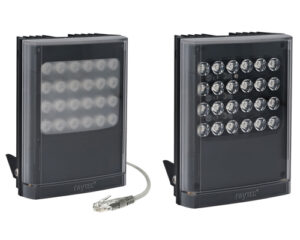 This illuminator is from Raytec’s latest range and is a hybrid design providing both Infrared and White light illumination from one network controlled device. The Infrared wavelength is centred on 850nm and a 940nm version is available on request. Power is by 4-Pair PoE or optionally through a separate 24v DC supply. The black housing incorporates a finned heatsink back panel and has a mounting bracket secured by 2 x 4mm hex screws. The bracket can be relocated from its lower position to the top of the unit to suit site mounting requirements.
This illuminator is from Raytec’s latest range and is a hybrid design providing both Infrared and White light illumination from one network controlled device. The Infrared wavelength is centred on 850nm and a 940nm version is available on request. Power is by 4-Pair PoE or optionally through a separate 24v DC supply. The black housing incorporates a finned heatsink back panel and has a mounting bracket secured by 2 x 4mm hex screws. The bracket can be relocated from its lower position to the top of the unit to suit site mounting requirements.
Getting started
By default, DHCP is disabled and the illuminator is configured with an address of 192.168.2.80 so must be changed to suit the intended subnet. The Raytec Discovery Tool can be downloaded from the Raytec website and when run will identify any associated devices on a connected network and allow the IP address to be manually changed. It was found on the small test network used (approximately 25 devices) that the discovery process would take over 5 minutes to run and that it was necessary to re-press the Discover button to update the display. This was the case with both a Windows 10 and a Windows 8 PC, though a direct PC to device link was immediate. Alternatively, the IP address can be changed by way of the device’s web page using a browser on a device set to the same 192.168.002.xxx subnet.
Power must be supplied from an external 24v DC 3A minimum power supply or by 4 wire PoE++ capable of supplying at least 51W. At 24v DC with IR at 100% the current drawn was 1.63A. In practice for set-up purposes, the unit can be run from a PoE+ 30W Midspan injector but will not be able to operate at 100% infrared output. If available power is exceeded then the device was found to simply reboot back to its default output value. Initial settings have IR set to 50%, perhaps for this reason, so it is important to ensure the power supply is adequate.
Menu settings
The main menu page is very clearly laid out with navigation options for the following:
Home – the initial page following Log On with access to lamp override functions.
Settings/Groups – lamp control with individual or group triggering.
Advanced Settings – manual override timing, input / output control and photocell sensitivity.
Access – management of Administrator and Operator (admin and user) passwords.
Network – device name and IPv4 address settings.
System Information – software version and device name plus factory reset / reboot options.
Diagnostics – status information and operational duration.
Advanced Diagnostics – operational voltage levels.
Software Update – file selection and upload.
Log Off – log the current administrator or operator out of the device.
The Home page provides the Override feature that allows either the Infrared or White light to be turned on or off. A countdown timer indicates when operation will be returned to automatic control if left overridden. This time can be changed on the Advanced Settings page from 10 to 480 minutes in 8 steps.
Settings / Groups allows control to be Local, i.e. from the photocell or external trigger, VMS, VMS + Local or HTTP. In the case of HTTP, the device will only respond to valid HTTP commands or those generated by the HTTP API, override is then not available. The Diagnostics page indicates Lamp and Power On durations but these are both returned to zero by a power re-cycle or factory reset.
Read the full review in the December 2017 edition of PSI magazine

